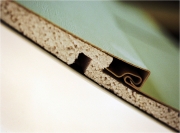The Character and Durability of Reclaimed Wood Flooring
What makes reclaimed wood so appealing? Its appeal is based on more than just the patina it has acquired during its years of use as a building material… the character associated with old wood started developing when it was still in the forest.
Wood utilized more than a century ago in the construction of old barns, factories, and warehouses throughout the United States is now one of the most highly desirable and sought-after raw materials in the flooring industry. Popular in both residential and commercial environments, vintage reclaimed wood flooring is appreciated by architects and designers for its history, quality, character, and environmental benefits.











